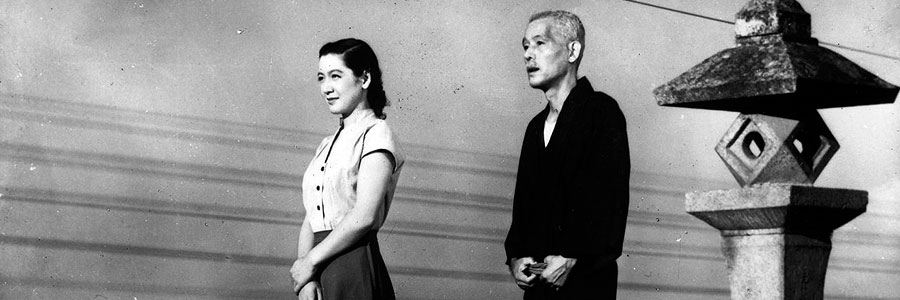
Tokyo Story

TOKYO STORY (MOVIE)
Shochiku
Original release: November 3rd 1953
Running time: 136 minutes
Country of origin: Japan
Original language: Japanese
Director: Yasujir? Ozu
Writer: Yasujir? Ozu, Kogo Noda
Cast: Chishu Ryu, Chieko Higashiyama, Setsuko Hara

When I borrowed Tokyo Story from the university library a few years ago, it wasn’t because it was required for one of my modules. I started to take an interest in Japanese cinema at the time and Yasujir? Ozu’s black and white classic was the only Japanese film that made it to the list of top ten films of all time by Sight & Sound. I wanted to see the film that had the privilege of being in the company of Hitchcock’s Vertigo, Eisenstein’s Battleship Potemkin, Orson Welles’s Citizen Kane and Kubrick’s 2001: A Space Odyssey.
The slow paced, minimalist telling of a simple story in a film that’s nevertheless quite lengthy with its running time of well over two hours had me puzzled at first. Tokyo Story can take some time to sink into and film critic Roger Ebert gave an apt description of his first experience of it:
This is an accurate summary of how I also felt about Tokyo Story; there was an initial sense of impatience due to false expectations that was gradually and seamlessly replaced by a profound connection to the story and especially the character of Noriko (Setsuko Hara). The young widower who lost her husband in World War II is truly a breath of fresh air amongst the many self-involved and oblivious characters in the film.

When the elderly couple Shukichi Hirayama (Chishu Ryu) and his wife Tomi (Chieko Higashiyama) set off from their home town to visit their children and grandchildren in the busy city of Tokyo, they soon find themselves neglected by their hosts. Noriko, however, who isn’t actually a blood relative to the old couple, goes out of her way to spend time with them.
This is where the pacing of the film plays out perfectly; the others welcome the old couple at first and the niceties peel off layer by layer, eventually revealing how they really feel about Shukichi and his wife as events play out. Anyone who’s ever attended a family gathering will be able to relate to the process of politeness slowly transforming into raw honesty in Tokyo Story.
Yasujir?’s camera passively observes interactions between family members while also giving us insight into characters dealing with everyday life in a post-war Japan.  One of the old couple’s sons was killed in the war and Noriko is one of the many women who were left single in a country transforming rapidly under western influence.
One of the old couple’s sons was killed in the war and Noriko is one of the many women who were left single in a country transforming rapidly under western influence.
We see one of the grandchildren studying English, we hear Shukichi telling an old friend their hometown hasn’t changed as it was fortunately not bombed during the war and when they have a bit too much to drink later, they also express disappointment in their children, shedding some light on the daily struggles before the economic miracle took place in Japan.
- Ebert, R Awake in the Dark: The Best of Roger Ebert (2006), University Of Chicago Press ¹
If I had to use one word to describe Tokyo Story, I’d say it’s ‘effortless’. The camera is static throughout; panning, tilt shots, point of view shots, extreme close-ups are all techniques Yasujir? Ozu chose not to use in the film. This minimalist visual style of the passive and unbiased observer clicks into place with seamless excellence for the telling of Tokyo Story.
As the story advances, a dramatic element is introduced by the sudden death of Tomi, which reveals even more about how the younger and busier generation can relate to their parents. The optimists amongst us can always hold onto Noriko as she offers kindness and humanity to the audience; this selfless character is played beautifully by Setsuko Hara, whose performance brings me back to the word I used to describe Tokyo Story as a whole: ‘effortless’.

Arpad Lukacs
Arpad is a Film Studies graduate and passionate photographer (he picked up the camera and started taking stills just as he began his studies of moving pictures). He admires directors that can tell a story first of all in images. More or less inevitably, Brian De Palma has become Aprad’s favourite filmmaker.
Then there’s Arpad’s interest in anime. He was just a boy when he saw Nausicaä of the Valley of the Wind on an old VHS and was hypnotised by the story of friendship, devotion and sacrifice. He still marvels at the uncompromising and courageous storytelling in Japanese anime, and wonders about the western audience with its ever growing appetite for “Japanemation”.
Have a look at Arpad's photography site, and you can follow him on Twitter @arpadlukacs.
© 2022 STATIC MASS EMPORIUM . All Rights Reserved. Powered by METATEMPUS | creative.timeless.personal. | DISCLAIMER, TERMS & CONDITIONS
HOME | ABOUT | CONTACT | TWITTER | GOOGLE+ | FACEBOOK | TUMBLR | YOUTUBE | RSS FEED
CINEMA REVIEWS | BLU-RAY & DVD | THE EMPORIUM | DOCUMENTARIES | WORLD CINEMA | CULT MOVIES | INDIAN CINEMA | EARLY CINEMA
MOVIE CLASSICS | DECONSTRUCTING CINEMA | SOUNDTRACKS | INTERVIEWS | THE DIRECTOR’S CHAIR | JAPANESE CINEMA





